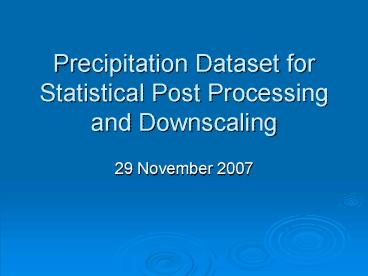Precipitation Dataset for Statistical Post Processing and Downscaling
1 / 14
Title:
Precipitation Dataset for Statistical Post Processing and Downscaling
Description:
Combines rain gage data w/ radar data (Mountain Mapper in West) ... Combine information from multiple sources: CMORPH. CPC Precipitation Analysis ... –
Number of Views:33
Avg rating:3.0/5.0
Title: Precipitation Dataset for Statistical Post Processing and Downscaling
1
Precipitation Dataset for Statistical Post
Processing and Downscaling
- 29 November 2007
2
Goals
- Create a historical precipitation dataset
- Needs to be quality controlled
- Needs to have a high spatial resolution
- Use this climatic precipitation dataset to
bias-correct GEFS and NAEFS precipitation
forecasts (1 resolution) - Use this dataset to downscale precipitation
forecasts to the high resolution NDFD grid (5 km
resolution) - Compute climate statistics for precipitation
3
Dataset
U.S. Domain (downscaling and bias correction)
- Combine information from two datasets
- CPC precipitation analysis
- Specifications
- Daily
- Since 2002
- 1/8 resolution
- 6-7 thousand daily reports
- Methods used to generate
- Uses inverse distance weighting for spatial
interpolation of gages - PRISM climatology for incorporating orographic
- Quality controlled (radar, satellite, station
checks) - RFC QPE
- Specifications
- Every 6 hours
- Since 2000
- 4-5 km resolution
- Methods used to generate
- Combines rain gage data w/ radar data (Mountain
Mapper in West) - Quality controlled by individual RFCs, then
mosaicked.
4
Dataset
North American Domain (NAEFS)
- Combine information from multiple sources
- CMORPH
- CPC ¼ Precipitation Analysis
- Same as 1/8 dataset, except uses modified
Cressman scheme to interpolate to grid - Canadian Precipitation Analysis (CaPA)
- Specifications
- 6-hourly
- 15 km grid
- Covers Canada and the U.S.
- Methods
- 6 hour forecast precip (GEM model) used as
background - Adjusted with rain gauges and radar data
- Being developed
5
Dataset
Global Domain (bias correction)
- Combine information from multiple sources
- CMORPH
- Specifications
- Every 30 minutes
- Since late 2002
- 8 km resolution
- Methods used to generate
- Precipitation estimates derived from low orbiter
satellite microwave observations - Precipitation features transported using
satellite infrared data, when microwave
observations are not available - Issues
- Poor estimates of precipitation over ice/snow
cover - Only extends to 60 N/S
- Will be replaced by RMORPH
- Early next year (March?)
- Incorporate rain gage data
- Back to 2000 (maybe 1998?)
6
Dataset
Global Domain (bias correction) (continued)
- GFS
- Will fill in data missing from CMORPH dataset (gt
60 N/S) - Use 12 hour forecast of 6-hour precipitation
(between 6 and 12 hours after initialization). - Issues
- Lower resolution
- Not observed precipitation
- Blending global and regional domains
- Precipitation values in U.S. domain may differ
between CMORPH and RFC QPE-CPC merged dataset - Should be better with RMORPH
- For now, scale CMORPH toward higher resolution
RFC QPE-CPC data, and incorporate Mexico/Canada
CPC rain gage data to help scale CMORPH
7
Comparison
8
Combining Datasets
- Methods similar to work by Ken Mitchell and
Youlong Xia - Temporally disaggregated the 1/8 CPC
precipitation analyses using Stage IV
precipitation (http//www.emc.ncep.noaa.gov/mmb/yl
in/pcpanl/stage4/). - Maintained 24 hour totals from CPC precipitation,
but added time variability from Stage IV
precipitation. - Original Resolutions
- CPC dataset 15 km resolution
- RFC dataset 5 km resolution
- NDFD 5 km resolution
- Interpolate grids to make combining simple
- RFC data ? 5 km NDFD grid
- CPC data ? 15 km grid that fits exactly over the
5 km NDFD grid
9
New Method First Interpolate Grids
CPC grid
RFC QPE grid
CPC grid fits exactly over RFC QPE grid (which
matches NDFD grid)
10
Scaling RFC QPE Against CPC
- Step 1
- CPC daily precip defined as precip from 12 UTC
12 UTC - Sum 6-hourly RFC QPE over same period to obtain
daily total
12-18 UTC
18-00 UTC
00-06 UTC
06-12 UTC
12-12 UTC
12-12 UTC
12-12 UTC
11
Scaling RFC QPE Against CPC
- Step 2
- Obtain average of all 9 points of RFC QPE grid
within each CPC grid box - Obtain scaling factor (1/2 in this example)
12-12 UTC
12-12 UTC
Average 20
Scaling factor CPCval / RFCtot (1/2 in this
example)
12
Scaling RFC QPE Against CPC
- Step 3
- Scale each 6-hourly RFC QPE grid by the scaling
factor obtained in step 2
12-18 UTC
18-00 UTC
00-06 UTC
06-12 UTC
½
12-18 UTC
18-00 UTC
00-06 UTC
06-12 UTC
13
End Result
- 5-year precipitation dataset
- 5 km resolution
- Confident in values (CPC truth)
- Already on NDFD grid
- Already incorporates quality controls
14
Missing Data
- Obtain average of all N points of RFC QPE grid
within each CPC grid box, where N is the number
of gridpoints with data - Obtain scaling factor (1/2 in this example)
12-12 UTC
12-12 UTC
- Average SumAllGoodPoints / N 140/7 20
- Scaling factor CPCval / RFCtot (1/2 in this
example) - Perform step 3 as usual
- For data missing across time dimension (eg. no
data at 18 UTC), fill gridpoint with time-average
of remaining points































